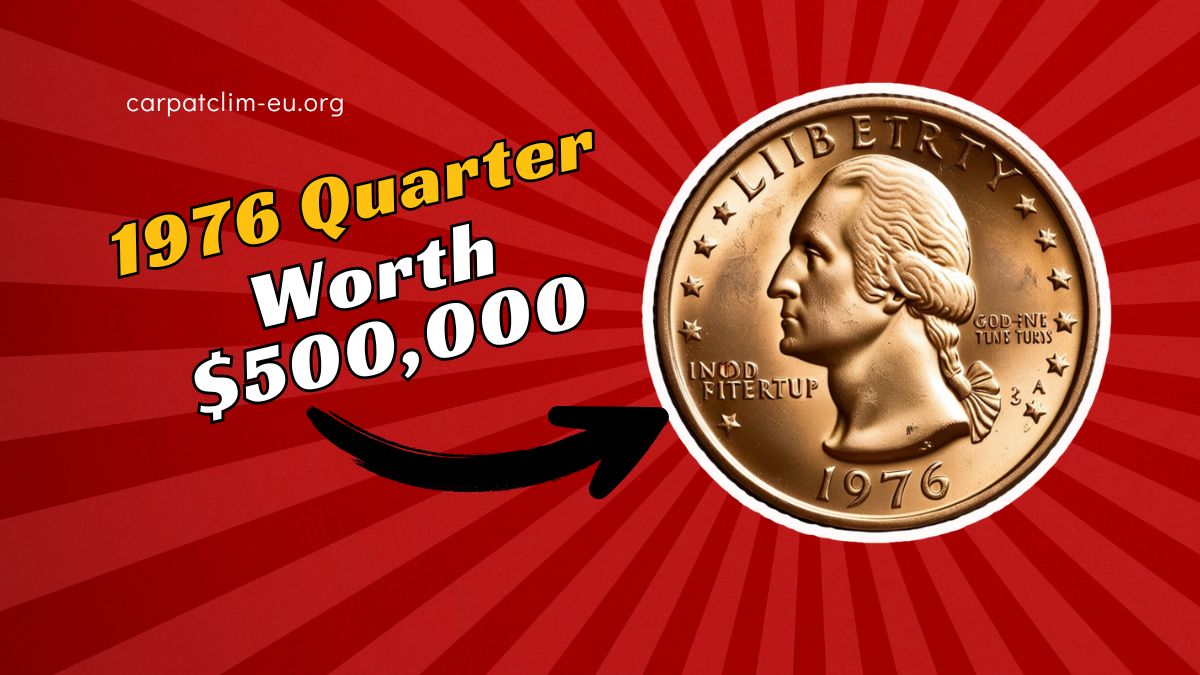The 1976 Quarter, originally designed to commemorate the U.S. Bicentennial, is an iconic piece of American history. While most 1976 quarters are worth just 25 cents, a rare variety has been making waves in the world of coin collectors, potentially fetching up to $500,000.
But what makes this particular 1976 quarter so special? In this article, we’ll dive into the details of this rare quarter, how to identify it, and whether you might have one hidden in your change jar.
The 1976 Bicentennial Quarter: A Quick Overview
In 1976, to mark the 200th anniversary of the United States, a special Bicentennial coin series was released. These coins, including the quarter, half dollar, and dollar, feature a unique reverse design that incorporates the Liberty Bell and 13 stars to represent the original 13 colonies.
While the general 1976 Bicentennial quarter is a popular piece in numismatics, it is not rare by itself. Most 1976 quarters can be found in circulation, and they hold a value equal to their face value of 25 cents. However, a particular variety of the quarter stands out due to its rarity and high potential value.
The Rare 1976 Quarter: What Makes it Special?
The 1976 quarter that could be worth up to $500,000 is a rare error coin, known as the “Doubled Die” variety.
This error occurs during the minting process when a coin is struck with a die that has been improperly aligned or doubled. As a result, the coin features a noticeable doubling of the lettering, date, and other elements on the reverse side.
For a 1976 quarter to be worth this kind of money, the doubling needs to be significant and clearly visible. This error is so rare that only a few examples are known to exist, making them highly sought after by collectors.
How to Identify a Rare 1976 Doubled Die Quarter
If you want to check whether you have a rare 1976 quarter, here’s a step-by-step guide to identifying a Doubled Die error:
| Key Feature | Details |
|---|---|
| Date and Mintmark | Look for visible doubling on the “1976” date and the mintmark “D” (for Denver-minted quarters). |
| Liberty Bell | Check for doubling along the edges of the Liberty Bell on the reverse side of the coin. |
| Inscriptions | Examine the words “E PLURIBUS UNUM” and “UNITED STATES OF AMERICA” for any noticeable doubling. |
| Visual Appearance | The doubling should be visible without magnification, but a magnifying glass can help spot the error. |
| Condition of Coin | The coin’s condition plays a major role in its value. The cleaner and well-preserved the coin, the higher the value. |
Why Are 1976 Doubled Die Quarters So Valuable?
The rarity of the Doubled Die 1976 quarter is what drives its value. While many people think of coins as being valuable based on their age or silver content, the true value often lies in the rarity of a specific error or misprint.
The value of these error coins is driven by:
- Scarcity: The 1976 Doubled Die quarters were not produced in large numbers, and only a handful of them have been discovered.
- Demand: Coin collectors, particularly those focused on U.S. errors, are always looking for rare coins to add to their collection. This creates competition and drives the price up.
- Condition: The better the condition of the coin, the higher its value. Coins that are in mint condition can fetch top prices, especially in auctions.
How Much Could a Rare 1976 Quarter Be Worth?
The value of a 1976 Doubled Die quarter can vary greatly depending on its condition and market demand. In general, here’s what you can expect:
| Condition | Estimated Value |
|---|---|
| Mint State (MS) 65 or higher | $500,000 (rare auction prices) |
| Uncirculated (MS 60) | $15,000 – $20,000 |
| Fine Condition | $2,000 – $4,000 |
| Circulated (Good Condition) | Around $500 – $1,000 |
While the highest known sales have reached half a million dollars, most examples of this error coin fall within the $2,000 to $20,000 range, depending on condition and other factors.
Where to Sell a Rare 1976 Quarter
If you happen to find one of these rare quarters, selling it is an option you might consider. Here are some avenues to explore:
- Online Auctions: Websites like eBay allow you to auction your coin to the highest bidder.
- Coin Dealers: You can take your coin to a reputable dealer who specializes in rare coins.
- Coin Shows: Attending a coin show can be an excellent way to connect with collectors and find the right buyer.
- Auction Houses: Some auction houses specialize in rare coins and can help you fetch a higher price for your coin.
The 1976 Bicentennial Quarter may be one of the most popular coins in American history, but a rare Doubled Die error variety can make you a significant amount of money.
If you happen to find one of these valuable quarters, you could be holding onto a treasure worth hundreds of thousands of dollars.
By carefully examining your coins for the doubling errors described above, you might just discover that the rare 1976 quarter in your possession could make you rich!
FAQs
How can I tell if my 1976 quarter is the Doubled Die variety?
Look closely at the date and mintmark for visible doubling. The doubling should be noticeable to the naked eye and even more apparent with magnification.
Are all 1976 quarters worth a lot of money?
No, only those with the Doubled Die error are worth significantly more than face value. Most 1976 quarters are worth just 25 cents.
What other U.S. coins are worth a lot of money due to errors?
Other valuable error coins include the 1955 Doubled Die Lincoln Cent, 2004-D Wisconsin State Quarter, and 1937-D 3-Legged Buffalo Nickel.




